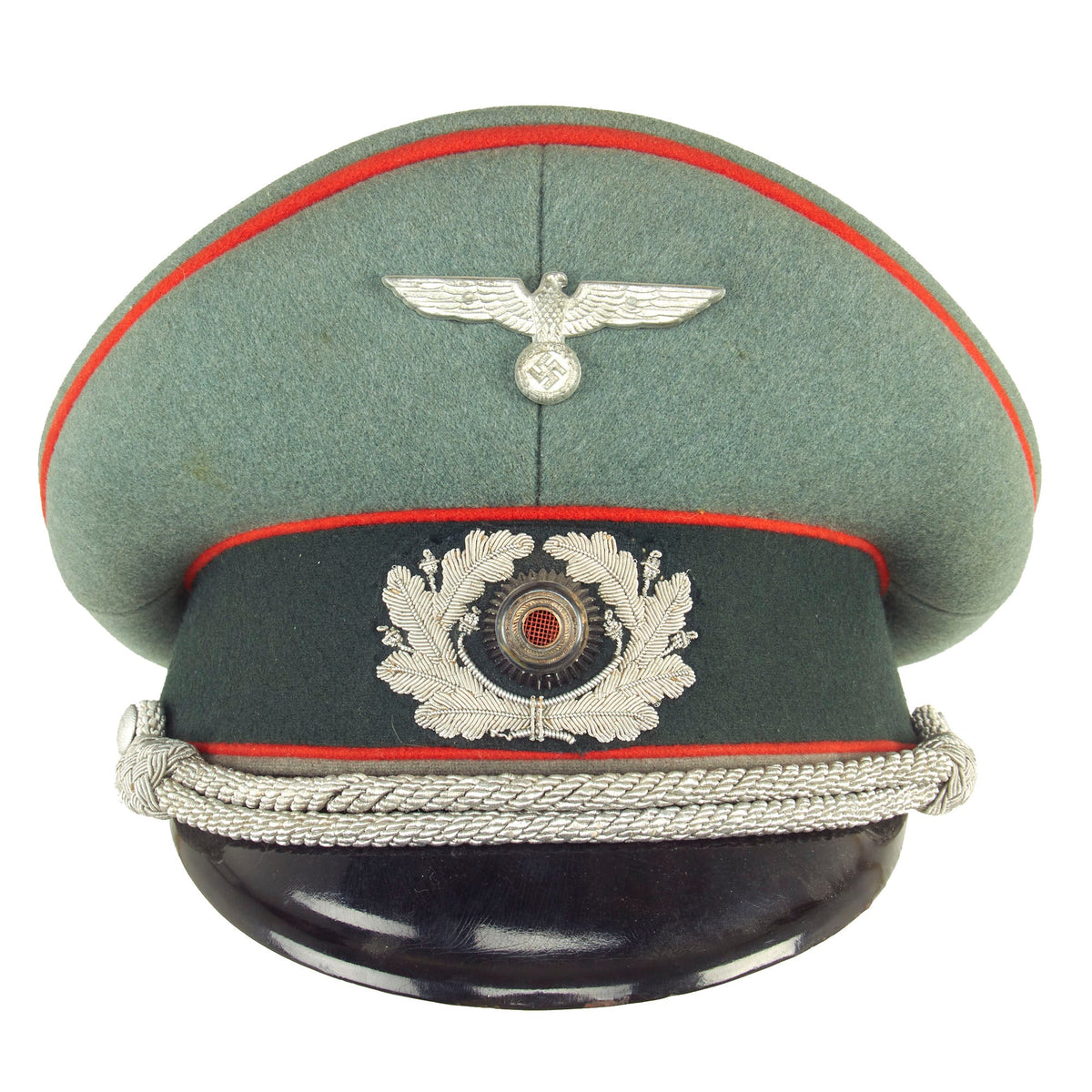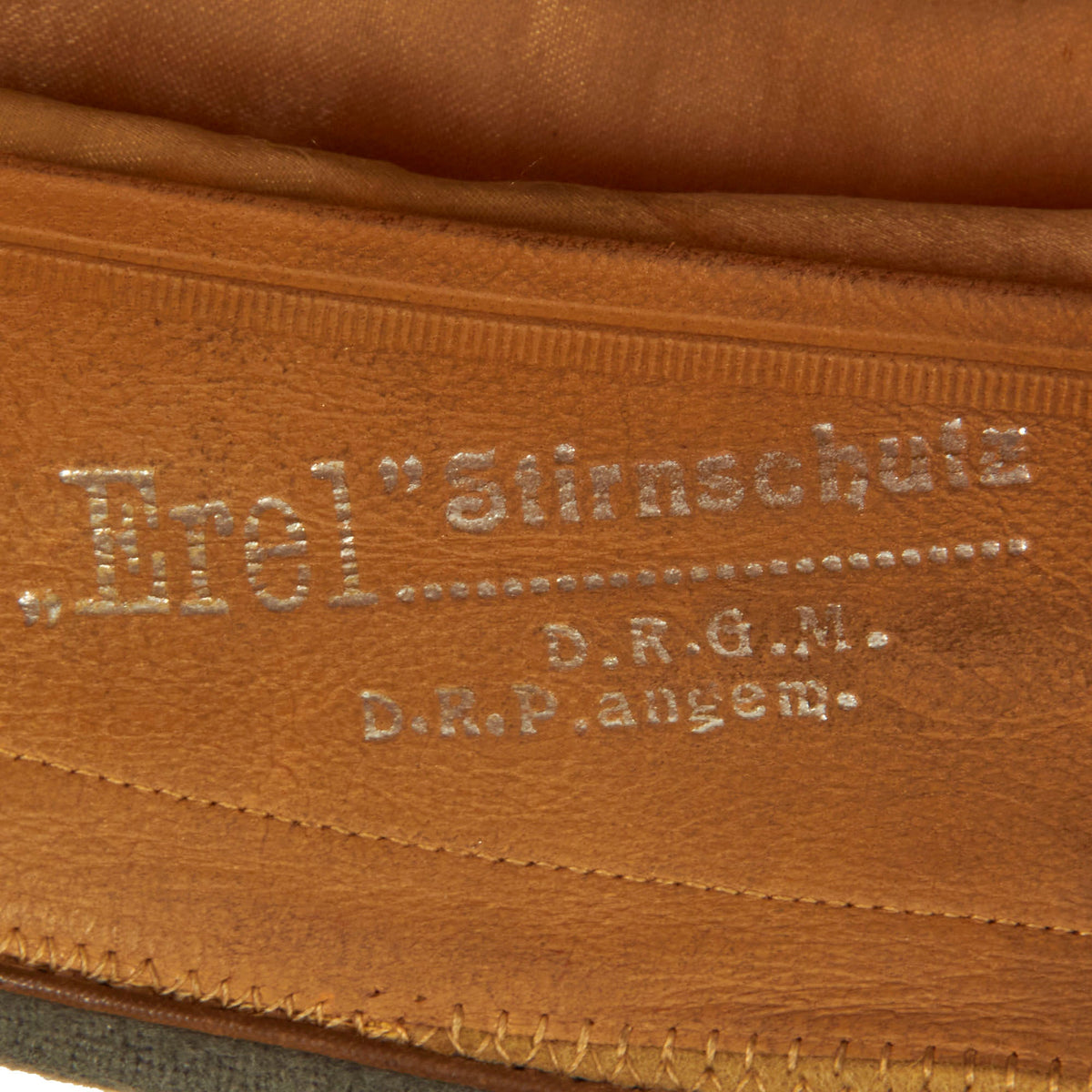Original German WWII Army Heer Artillery Officers Schirmmütze Crush Visor Cap by Peküro / EREL Original Items
$ 895,00 $ 223,75
Original Item: Only One Available. This cap is a wonderful lightly used example of a named German WWII Wehrmacht Heer Army Artillery Officer’s Schirmmütze (visor cap), and it really looks the business. The cap has a lovely “Crushed” or “saddle-form” shape that is highly desirable, accomplished by removing the crown support stiffener ring. Of interest is that it is marked by TWO different makers, both of which are highly desirable: Peküro on the lining and EREL on the sweatband. We have examined the cap closely, and the stitching all is high quality period.
Based on the specific design of the front oak leaf wreath, we believe this is a Peküro cap that has an EREL sweatband in it, installed at the factory during the war. We haven’t really seen an example like this before, with some great research potential. Regardless of the maker, the visor cap features lovely feldgrau (field gray) “doe skin” weave wool construction with a forest green “badge cloth” band and a traditional high forward crown. The also has matching Hochrot (Deep Red) piping along the top edge and flanking either side of the band, the Corps Color (Waffenfarbe) for Artillery, as well as General Level Officers. It has the correct silver bullion chin strap, indicating that it is for an officer.
It is decorated with a well detailed silvered zinc eagle insignia on the peak and and an open cast aluminum bullion hand embroidered oak leaf and acorn wreath surrounding a metal tri-color cockade on the band. The silver wash on the eagle is well retained, with just a bit of light oxidation, and the wreath is still fully bright and shiny. The cockade looks to be possibly silver plated, which has now tarnished, and it has a red metal mesh insert in the center. The chin strap is attached with the standard pebbled buttons on either side of the cap. The vulcanfibre visor has a smooth black leather-look upper, exhibiting minimal wear along the edge and is beige on the underside. The top has a lovely pattern of fine crazing and fine checking on much of the surface.
The inside of the cap is lined with lovely cream colored rayon faux silk, which shows very little staining or wear of any kind. The top celluloid sweat shield is nearly 100% complete, with full stitching, and still bears the original maker logo printed in black on the exterior:
Peküro
Stirndruckfrei
DEUTSCHES REICHSPATENT
The tan leather sweatband is in very good near excellent condition, still soft and supple with very little wear. There is a gold embossed maker marking on the left side of the liner that reads: „Erel“ Stirnshutz / D.R.G.M. / D.R.P. angem., which refers to the “Forehead Protection” of the sweatband design. The additional abbreviations indicate that it is a trademarked and protected design. It also looks to have been modified slightly by having some larger vent holes along the forehead perforated region.
Overall condition is really very good, with the colors still extremely vibrant, and no real mothing that we can see. From what we can tell, this cap is about a size 58cm / US 7 1/4.
A great example of a classic hat worn by German Army Artillery Officers in WWII. Very impressive and ready to display!
The German Schirmmütze Visor Cap:
The visor cap (Schirmmütze) was an important part of the headgear worn by German uniformed military, civil, paramilitary and political organizations during the Third Reich. This was the standard cloth headgear worn as a part of the service uniform. Visor caps were worn outdoors as well as indoors, and were often required to be worn by all personnel on duty. Visor caps were made in versions specific to each organization and were often further differentiated through the use of insignia, colored piping, or style of chin cord, to indicate rank, role or branch. The insignia used on these caps ranged from simple stamped metal emblems, to elaborate hand embroidery. Visor caps were issued to enlisted soldiers and NCOs in the military and in some other organizations. Officers had to purchase their own hats, and lower ranks could choose to purchase caps that were of a higher quality than the rather basic, issue examples. The private purchase caps were generally made in very high quality, with fine materials. A wide variety of fabrics were used, from Trikot and doeskin, to heavy wool, or even lightweight white fabric for summer wear. In the military, issue of these caps was generally suspended shortly after the outbreak of the war, but they continued to be worn by some troops until the end of the war.
Fast Shipping with Professional Packaging
Thanks to our longstanding association with UPS FedEx DHL, and other major international carriers, we are able to provide a range of shipping options. Our warehouse staff is expertly trained and will wrap your products according to our exact and precise specifications. Prior to shipping, your goods will be thoroughly examined and securely secured. We ship to thousands clients each day across multiple countries. This shows how we're dedicated to be the largest retailer on the internet. Warehouses and distribution centres can be located throughout Europe as well as the USA.
Note: Orders with more than one item will be assigned a processing date depending on the item.
Before shipping before shipping, we'll conduct a thorough inspection of the items you have ordered. Today, the majority of orders will be delivered within 48 hours. The delivery time will be between 3-7 days.
Returns
The stock is dynamic and we cannot completely manage it because multiple stakeholders are involved, including our factory and warehouse. So the actual stock may alter at any time. It's possible that you may not receive your order once the order has been made.
Our policy is valid for a period of 30 days. If you don't receive the product within 30 days, we are not able to issue a refund or an exchange.
You can only return an item if it is unused and in the same state as the day you received it. You must have the item in its original packaging.
Related products
Uncategorized
Uncategorized
Uncategorized
Uncategorized
Uncategorized
Uncategorized
Uncategorized
Uncategorized
Band of Brothers ORIGINAL GERMAN WWII Le. F.H. 18 10.5cm ARTILLERY PIECE Original Items
Uncategorized
Uncategorized
Angolan Rebel 1970s era 60mm Inert Display Mortar from Angolan Civil War Original Items
Uncategorized
Uncategorized
Uncategorized
Armored Burgonet Helmet & Polearm from Scottish Castle Leith Hall Circa 1700 Original Items
Uncategorized
Uncategorized
Uncategorized
Uncategorized













































































